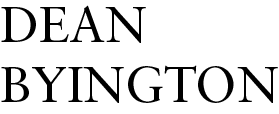Introduction To The Leslie Tonkonow Catalog, 2007
Carter E. Foster,Steven And Ann Ames Curator Of Drawing, Whitney Museum Of American Art
THE LANDSCAPES IN DEAN BYINGTON'S WORK unfold slowly to a meandering eye rather than a single, unified gaze. Though technically paintings -- they are alkyd oil paint on stretched linen canvas -- they result from a labor-intensive combination of collage, printing, and painting, their imagery both invented and appropriated by the artist, using the graphic language of nineteenth-century illustrated books.
Byington is a self-described enthusiast of "horror vacuii" (the term used to describe the thrill of ornamentation, with no surface left untouched, such as those found in rococo interiors). In such an esthetic, various ornamental forms lead the eye rhythmically into and out of different spaces -- across surfaces that project, recede, and interconnect. He achieves this kind of decentered, disorienting effect through objects with a resolute flatness. In works such as Hinterland I (2007) and New Destruction (2007), some remnants of the recessional space associated with traditional landscape painting remain: a horizon line orients the viewer and objects diminish in size the closer they are to this. But in looking at them, one also has the strange feeling of walking into a pattern. The space in Underground 4 (2007), follows its own laws: in this weird, cave-like realm, the botanical and the geologic combine to form pockets and openings that carve back space from the surface while the flatness of their outlines produces repetitions across it. One of Byington's most virtuosic ontical games is the creation of a visual language that resembles, but is not, a pattern. Motifs repeat -- stalactites, stalagmites, and flowers cover the canvas -- but they vary individually and shift into many configurations; similarly, the grotto-like pockets that complicate the painting are irregularly nuanced.
The collages that the artist has made in this current body of work provide us with a window into his technique. These seamless, obsessive pieces, pulled together from hundreds of hand-cut bits of paper, are the basis of Byington's process. He collects nineteenth-century illustrated books and has trained himself to draw in the highly stylized manner of wood engravers from that period. Over time, friends who know his taste have also sent him material found in flea markets and book stores in Europe and America.
To make the paintings, Byington first photocopies his own drawings, illustrations from the books, prints, and sometimes actual objects, adjusting the scale as needed. He then creates a collage, which serves the same function as a traditional cartoon -- a one-to-one design that is transferred to the matrix of the final work. To transform this into a painting, the artist makes a photographic mosaic of the collage and scans this into a computer. From these images, he creates silkscreen panels, which are printed onto linen using oil paint, each screen becoming a "tile" in the overall composition. Finally, he meticulously paints in the interstices between to make the composition seamless. The resulting works seem equal parts graphic and painted. The technique of screen-printing found imagery, used by artists ranging from Andy Warhol to Sigmar Polke, results in several layers of process standing between the artist's hand and the created object, a state that Polke has described as one that turns the artist into a kind of ghost. This idea has much appeal for Byington, but he combines it with his own need to "get as much information into [the work] as possible -- shoehorn it in." The imagery he uses is visually dense to begin with. The illustrations he prefers are typically wood engravings, a monochromatic medium that is incredibly intricate in the way that it conveys the rendered object through linear networks. It is no small feat that the artist has taught himself to draw and paint in this manner, a stylistic appropriation that totally transforms his source material. By weaving the found and the invented ever more tightly, Byington pushes us into a controlled visual overload.
The all-consuming quality of his work links the artist to an important group of West Coast practitioners. He has found a way to push the aesthetic that developed there in the 1950s and 1960s into something that eliminates and moves beyond two of the fundamental properties of collage -- edge and overlap. One also thinks of the "finish fetish" work of John McCracken or the ceramicist/sculptor Ken Price, both obsessive in their use of surface density to create optically captivating art. Byington's method has parallels to theirs in that the final product is a summation of many layers of production. In a number of the pieces he applies transparent overlays of the same alkyd paint he uses to screen-print the lines, adding them on top of the images without completely obscuring them. By building layer upon layer of this oil wash, he paradoxically creates a ground that lies physically on top of the image. The result is that the works seem to be modulated by monochromatic; surfaces that appear somewhat impenetrable from a distance, open up to the viewer on closer inspection.
The artist, in fact, directly addresses this idea in a new untitled collage: a staircase floats on the surface, suggesting to us an actual pathway into the piece. In the more graphic, black and white works, this path is relatively readable, but in the subtler colored monochromes such as Cathedral (2007) and Tourmaline (2006), one has to look closely to extract the image/figure from the color/ground to which it is so closely tied in value. Byington's optical play here is a further way of underscoring the somewhat hallucinatory overall effect of these large-scale paintings. As the artist himself describes it: "You go through a door down into a place and can't find the door again -- what is that world going to look like?"
